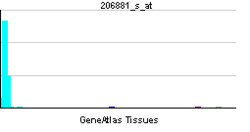LILRA3
Leukocyte immunoglobulin-like receptor subfamily A member 3 (LILR-A3) also known as CD85 antigen-like family member E (CD85e), immunoglobulin-like transcript 6 (ILT-6), and leukocyte immunoglobulin-like receptor 4 (LIR-4) is a protein that in humans is encoded by the LILRA3 gene located within the eukocyte receptor complex on chromosome 19q13.4. Unlike many of its family, LILRA3 lacks a transmembrane domain. The function of LILRA3 is currently unknown. however it is highly homologous to other LILR genes,[2] and can bind human leukocyte antigen (HLA) class I. Therefore, if secreted, the LILRA3 might impair interactions of membrane-bound LILRs (such as LILRB1, an inhibitory receptor expressed on effector and memory CD8 T cells) with their HLA ligands, thus modulating immune reactions and influencing susceptibility to disease.[3][4][5]
Like the closely related LILRA1, LILRA3 binds to both normal and 'unfolded' free heavy chains of HLA class I, with a preference for free heavy chains of HLA-C alleles [6]
See also
References
- ↑ "Human PubMed Reference:".
- ↑ Torkar M, Haude A, Milne S, Beck S, Trowsdale J, Wilson MJ (December 2000). "Arrangement of the ILT gene cluster: a common null allele of the ILT6 gene results from a 6.7-kbp deletion". European Journal of Immunology. 30 (12): 3655–62. doi:10.1002/1521-4141(200012)30:12<3655::aid-immu3655>3.0.co;2-y. PMID 11169408.
- ↑ Arm JP, Nwankwo C, Austen KF (September 1997). "Molecular identification of a novel family of human Ig superfamily members that possess immunoreceptor tyrosine-based inhibition motifs and homology to the mouse gp49B1 inhibitory receptor". Journal of Immunology. 159 (5): 2342–9. PMID 9278324.
- ↑ Borges L, Hsu ML, Fanger N, Kubin M, Cosman D (December 1997). "A family of human lymphoid and myeloid Ig-like receptors, some of which bind to MHC class I molecules". Journal of Immunology. 159 (11): 5192–6. PMID 9548455.
- ↑ "Entrez Gene: LILRA3 leukocyte immunoglobulin-like receptor, subfamily A (without TM domain), member 3".
- ↑ Jones DC, Kosmoliaptsis V, Apps R, Lapaque N, Smith I, Kono A, Chang C, Boyle LH, Taylor CJ, Trowsdale J, Allen RL (March 2011). "HLA class I allelic sequence and conformation regulate leukocyte Ig-like receptor binding". Journal of Immunology. 186 (5): 2990–7. doi:10.4049/jimmunol.1003078. PMID 21270408.
Further reading
- Samaridis J, Colonna M (March 1997). "Cloning of novel immunoglobulin superfamily receptors expressed on human myeloid and lymphoid cells: structural evidence for new stimulatory and inhibitory pathways". European Journal of Immunology. 27 (3): 660–5. doi:10.1002/eji.1830270313. PMID 9079806.
- Cella M, Döhring C, Samaridis J, Dessing M, Brockhaus M, Lanzavecchia A, Colonna M (May 1997). "A novel inhibitory receptor (ILT3) expressed on monocytes, macrophages, and dendritic cells involved in antigen processing". The Journal of Experimental Medicine. 185 (10): 1743–51. doi:10.1084/jem.185.10.1743. PMC 2196312
 . PMID 9151699.
. PMID 9151699.
- Colonna M, Navarro F, Bellón T, Llano M, García P, Samaridis J, Angman L, Cella M, López-Botet M (December 1997). "A common inhibitory receptor for major histocompatibility complex class I molecules on human lymphoid and myelomonocytic cells". The Journal of Experimental Medicine. 186 (11): 1809–18. doi:10.1084/jem.186.11.1809. PMC 2199153
 . PMID 9382880.
. PMID 9382880.
- Wiśniewski A, Łuszczek W, Mańczak M, Jasek M, Kubicka W, Cislo M, Kuśnierczyk P (April 2003). "Distribution of LILRA3 (ILT6/LIR4) deletion in psoriatic patients and healthy controls". Human Immunology. 64 (4): 458–61. doi:10.1016/S0198-8859(03)00025-9. PMID 12651072.
- Norman PJ, Carey BS, Stephens HA, Vaughan RW (June 2003). "DNA sequence variation and molecular genotyping of natural killer leukocyte immunoglobulin-like receptor, LILRA3". Immunogenetics. 55 (3): 165–71. doi:10.1007/s00251-003-0561-1. PMID 12750859.
- Zhang Z, Henzel WJ (October 2004). "Signal peptide prediction based on analysis of experimentally verified cleavage sites". Protein Science. 13 (10): 2819–24. doi:10.1110/ps.04682504. PMC 2286551
 . PMID 15340161.
. PMID 15340161.
External links
This article incorporates text from the United States National Library of Medicine, which is in the public domain.
|
|---|
|
| 1-50 | |
|---|
|
| 51-100 | |
|---|
|
| 101-150 | |
|---|
|
| 151-200 | |
|---|
|
| 201-250 | |
|---|
|
| 251-300 | |
|---|
|
| 301-350 | |
|---|

 . PMID 9151699.
. PMID 9151699. . PMID 9382880.
. PMID 9382880. . PMID 15340161.
. PMID 15340161.